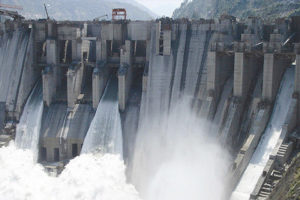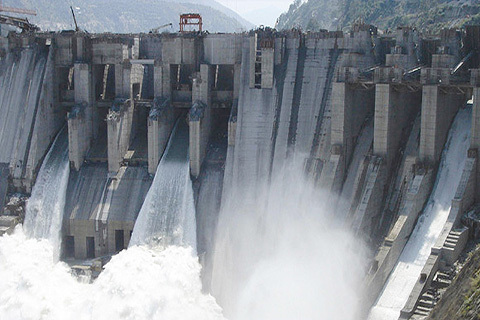Hydropower Development in India and in J&K – An overview
Iftikhar A Drabu
 Recently a very senior retired bureaucrat of our state commented that India was viable as a state only after stealing our hydro power. I thought it is time to share some statistics about hydro power in India and in Kashmir to put things in a perspective.
Recently a very senior retired bureaucrat of our state commented that India was viable as a state only after stealing our hydro power. I thought it is time to share some statistics about hydro power in India and in Kashmir to put things in a perspective.
While it is a fact that J&K is blessed with abundant hydro power potential it is also a fact that some other states in India have a much larger hydro power potential. The table below provides an overview of the hydro power potential of four states (three northern and one north eastern) which account for nearly 70% of the total hydro power potential of India. As you can see in the table, just the state of Arunachal has more than one third of the total potential of India. The next three states (HP, UK & J&K) in order of their hydro power potential together add up to the potential of Arunachal Pradesh.
The last column of the table provides the ratio of hydro potential in MW to population in lacs. This ratio gives you an idea of distribution of hydro potential per capita. As you can see in the ratio for Arunachal is more than 30 times the ratio for J&K while Himachal is more than 2.5 times our ratio.
State Potential
(MW) Developed (MW) Under Construction (MW) Yet to be Developed (MW) Population (Lacs) Ratio: (MW/Lac)
J&K 13,543 3,119 1,180 9,244 125.49 108
UK 17,998 3,756 1,805 12,437 101.16 178
HP 18,540 9,481 2,043 7,016 68.56 270
Arunachal 50,064 405 2,854 46,805 13.82 3623
All India 145,320 37,261 11,958 96,101
Out of the total hydro potential of 145,320MW in India, J&K at 13,543MW accounts for less than 10% of that. I am sure there will be differing opinion on the hydro potential of J&K with people estimating it in excess of 30,000MW but these figures here from Central Electricity Authority of India website. Just to add here these figures exclude small hydro projects, below 25MW capacity, which at all India level are less than 3,400MW. In any case we are using these figures in relatively and not in absolute terms.
The developed capacity of 37,261MW accounts for only 26% of the total potential. While J&K has developed less than 23% of its potential, Himachal has developed more than 50% of its potential and Arunachal, with the maximum potential, has developed less than 1% of its potential.
Out of this developed capacity the central hydro power generating utilities account for nearly 40% of the total i.e. 14,456MW. These central utilities include NHPC, NTPC, BBMB, NEEPCO, SJVNL, THDC, DVC and NHDC. While the former are Government of India companies, SJVNL is a joint venture between Govt. of India and Himachal Government, THDC is joint venture between Govt. of India and UP Govt., DVC is run by Govt. of India and Governments of Bengal and Jharkhand. NHDC is joint venture of NHPC and Govt. of Madhya Pradesh. CVPPL, a joint venture between JKSPDC, NHPC and PFC, is not considered here since it neither has any plant operational nor under execution.
Out of the total installed capacity of 14,456MW of these central hydro generating stations, J&K accounts for only 14% (2009MW) while Himachal has the bulk of installed capacity of such stations at 51% (7367MW). These include projects developed by NHPC, NTPC, SJVNL and BBMB in Himachal. Some reports tend to exclude the BBMB capacity (2884MW) from that of Himachal but I have included them in my numbers.
Central Hydro Generating Stations across various states
State Installed Capacity (IC) – MW Percentage of CHGS IC
J&K 2,009 14%
HP 7,367 51%
UK 1,774 12%
Others 3,305 23%
Total 14,456 100%
In the state sector Himachal has developed a little over 366MW while in private sector it has developed about 1750MW. J&K has over 1,200MW of operational plants in state sector, with very small privately developed plants. Uttarakhand on the other hand has more than 1250MW in state sector and about 730MW in private sector.
Looking at NHPC it fully owns 5,041MW and has a 50% stake in NHDC which has 1,520MW installed capacity. Effectively it NHPC owns 5,801MW out of which 2,009MW are in J&K. This translates to 35% of its total capacity. Himachal is at number two at 31%. On completion of the under execution NHPC projects the installed capacity in Himachal would increase to 2,571MW (remaining though at 31%) but in J&K though the capacity would increase to 2,339MW its share would drop from 35% to 29%.
Overview of NHPC Projects across various states
State Installed Capacity (IC) – MW Percentage of NHPC IC
J&K 2,009 35%
HP 1,771 31%
UK 374 6%
Others 887 15%
NHDC – 50% 760 13%
Total 5,801 100%
The under execution projects of NHPC (3,130MW), NTPC (819MW), THDC (1,468MW), NEEPCO (770MW) add up to 6,187MW and out of this only 330MW are being developed in J&K. Once these under execution projects are completed the share of J&K projects in the central hydro generating stations would drop from 14% to 11%.
On completion of these under execution projects Himachal would have developed 55% of its potential, Uttarakhand would move from the current 21% to 32% while J&K would move two points from the current 23% to 25% since only the 330MW Kishanganga HEP of NHPC is under execution.
As can be seen from above, we are not the No 1 state in hydro power potential but we still are the fourth largest in the country. Himachal has made good progress and managed to develop a large percentage of its potential though mainly through joint ventures with different central government utilities and through private sector. Unfortunately private sector is no longer keen in investing in this sector.
While I am not advocating the same approach of joint ventures with central utilities for J&K, but we need to understand how we can gainfully develop our projects. We cannot afford to be emotional about the issue but instead need to deliberate upon the way forward and develop a strategy for gainfully harnessing our hydro power potential.
Iftikhar A Drabu is a civil engineer from REC (now NIT), Srinagar.





